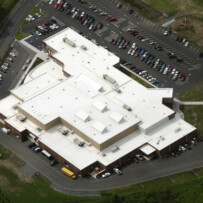
As hard as it is to believe, fall is here – across the country, most kids have finished mourning the end of summer vacation and have settled into the routine of a new school year. For more than 14 million students in our K-12 public schools, the fall semester means coming back to a building that doesn’t meet basic construction codes, is overcrowded, or both. As parents, this is cause for alarm – as part of the commercial roofing industry, it’s also an opportunity.
There are roughly 100,000 public elementary and secondary school buildings in the U.S. (and as many as 35,000 more private K-12 schools). The National Center for Education Statistics and U.S. General Accounting Office have estimated that at least a third of these facilities need extensive repairs or renovations. And as the school-age population grows, the need for expansions and new buildings grows, too.
The educational sector is beginning to show positive signs. Major economic forecasts like McGraw-Hill and Moody’s predict that slightly-shrinking 2014 spending will give way to nearly six percent growth in education-related construction in 2015 – on pace with commercial construction in the private sector.
School administrators and facility engineers want what all building owners want – solid construction, energy efficiency, low operating and maintenance costs. A high-performance GenFlex roofing system checks all of these boxes…and earns extra credit:
Durability. School budgets are always tight; GenFlex roofing membranes deliver long-term value through exceptional durability, standing up to tears, punctures and typical roof traffic as well as the changing seasons. Given concerns over indoor air quality and mold – especially with the rise in asthma and other respiratory ailments among children – it’s important to note that GenFlex ‘Peel and Stick’ technology for both EPDM and TPO membranes creates strong, water-resistant seams that keep moisture (and mold) at bay. And GenFlex was the first roofing brand to offer 12’ wide TPO sheets, for fewer installation seams and fewer opportunities for water infiltration.
Healthy products. Chemical emissions are another important environmental issue in schools – school buildings are up to five times as crowded as the typical office, and young children are especially sensitive to the Volatile Organic Compounds (VOCs) used in many building products. So even in roofing products, avoiding these chemicals is a plus. GenFlex offers a full line of low-VOC adhesives and primers to neutralize the issue. GenFlex TPO membrane is also free of the phthalate additives used in some competitive products (like some PVC roofing); these toxic chemicals are under increased scrutiny by the EPA and standard-setting bodies like the U.S. Green Building Council.
Taking the heat. GenFlex roofing systems offer year-round energy efficiency, with polyiso insulation options that provide better R-value performance per inch than other roofing insulations. With school years getting longer, students are often in class during the ‘dog days’ of August, and as temperatures begin to rise in May and June. Especially in southern markets, these conditions mean higher HVAC costs or uncomfortable classrooms – but GenFlex White TPO membranes reflect away the sun’s heat, helping keep the building interior cool. These products are EnergyStar-certified, and meet the strict requirements of the U.S. Green Building Council’s LEED certification. With more than three decades and a billion square feet of installed roofing, GenFlex has earned a place at the head of the class – and when it comes to school construction, our full line of single-ply roofing membranes, insulations and accessories help our contractors make the honor roll, too.
For more information on GenFlex products and programs, visit www.GenFlex.com – to request training on product-specific installation and maintenance practices, click here.
